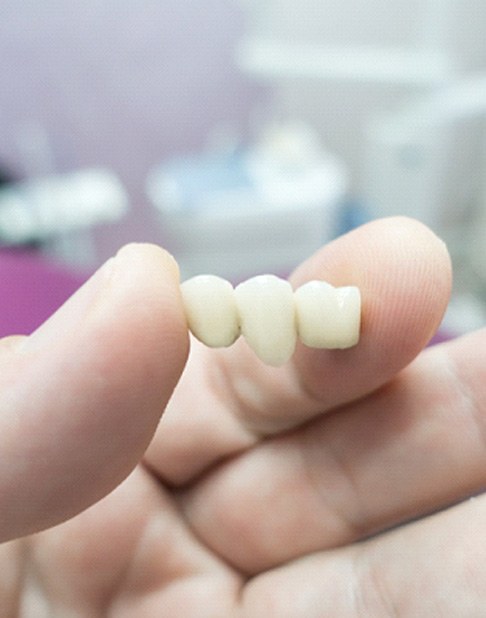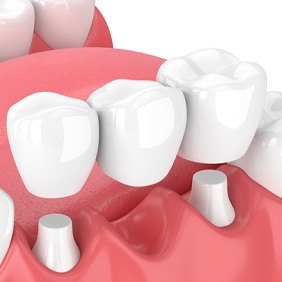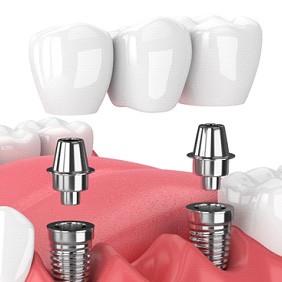Dental Bridges – New York, NY
Bridge the Gap in Your Grin
No one wants to be missing a tooth, but thanks to modern restorative dentistry you always have several smile solutions. When you are missing one or a few consecutive teeth but your teeth on either side of the gap are healthy, a dental bridge definitely merits consideration. At FS Dental Arts, count on our dentists to bridge the gap in your grin to restore its appearance and balance, plus this new addition will prevent dental drift and reduce your risk of gum disease. Contact your restorative dentist in New York to schedule a consultation!
What Is a Dental Bridge?

Dental bridges are designed to help patients who are missing one tooth or several teeth in a consecutive row. An alternative to partial dentures, this tried-and-true tooth-replacement solution uses dental crowns or dental implants to secure the pontics (free-standing replacement teeth) in place. Since the materials used are available in a wide range of lifelike shades, modern dental bridges fill the gap in your smile seamlessly. Plus, they are incredibly durable, ensuring your bite doesn’t suffer either!
Types of Dental Bridges

The first step to regaining your primetime grin is a consultation with Dr. Sanchez. She’ll conduct an oral examination, ask about your goals, and review your medical history. Based on her findings, one of the following treatment options will be recommended:
Traditional Dental Bridge

A traditional dental bridge can replace a single missing tooth or several teeth in a row. This restorative treatment requires you to have a natural, stable adjacent tooth in front of and behind the space that you’re wanting to fill in. Essentially, we’re “bridging the gap” by making a single unit of three or more teeth.
Implant Bridge

As the name implies, an implant bridge uses dental implants as opposed to crowns. The implants are placed on either side of the gap in your smile, and after they’ve fused with the jawbone, we’ll be able to attach the dental bridge to the implants to replace two or more missing teeth. Considered the strongest and most stable system, an implant-supported bridge requires surgery to embed the implants into the jawbone. Your time invested in this option will pay off in the quality of the result!
The Benefits of Getting a Dental Bridge

When you replace your missing teeth with a dental bridge in New York, you can expect to enjoy an array of benefits including:
- Maintained alignment of your existing teeth
- Improved oral health
- Easy cleaning and maintenance
- Jawbone preservation with implant bridges
- Long-lasting results (15 years with traditional & 35+ with implant-supported)
- Natural-looking smile
Dental Bridges FAQs

Do you have one or several missing teeth in a row? One of the most effective and popular ways to address this is a dental bridge. These porcelain restorations will close the gaps in your smile, allowing you to eat comfortably, speak clearly, and smile confidently again! That said, it’s normal to want to know as much as you can about the treatment before committing to any procedures. To help you feel well-informed and confident in your decision, our team has gathered and answered some of the most frequently asked questions about this restoration option. Read on or reach out to us today if you want to learn more about dental bridges in New York.
Do Dental Bridges Look Natural?
Dental bridges that are constructed out of porcelain material can be specifically color-matched to fit your surrounding pearly whites. This means they’ll seamlessly blend in with the rest of your smile, especially since they’ll reflect light similar to natural tooth enamel. After being placed, your restoration should look and feel like your permanent teeth, as most people won’t even be able to notice the difference. Additionally, since they aren’t like dentures that rely on suction to your gums, you won’t have to worry about your bridge shifting out of place. Your new teeth should remain sturdy for many years to come.
How Long Should a Dental Bridge Last?
While this will heavily depend on the type of material used to create your restoration, dental bridges can usually last anywhere between 5 and 15 years. Their lifespan will also be affected by various factors, such as your oral hygiene, diet, and whether you have poor oral habits, such as smoking, teeth grinding, chewing on ice, and biting your nails. Dental bridges that renew front teeth typically last much longer than those placed in the back of the mouth, as they won’t need to withstand excessive pressure from chewing. If you have an implant bridge, then you can expect it to last many years longer than a traditional one.
Can You Take a Dental Bridge Out?
Unlike dentures, you should not be able to take out your dental bridge whenever you want. These restorations are designed to stay in your mouth for as long as possible before you need to replace them. The only one who can take your bridge out is your dental professional. Some healthcare providers refer to partial dentures as “removable bridges,” but these two options should not be confused. Partials are similar to bridges, as they can close the gaps in your smile. The main difference is that you can remove partial dentures at any time, while you cannot do the same with a bridge.
How Many Teeth Can a Dental Bridge Replace?
This will depend on the patient’s dental needs, but a dental bridge is generally used to replace around one to four missing teeth in a row. However, in most situations, this restoration is typically used to restore only one or two pearly whites. This is because the longer the bridge extends, the less stability it will provide for your smile. It can become risky if you replace three or more teeth with this restoration, as you might end up needing to replace them prematurely, adding to the overall cost of your treatment. Implant bridges can significantly reduce this risk, as your restoration will be directly anchored to your jawbone instead of your neighboring healthy teeth.
